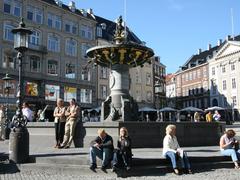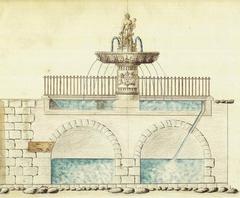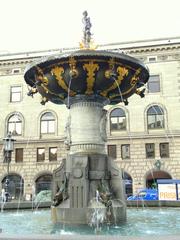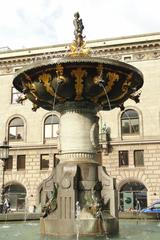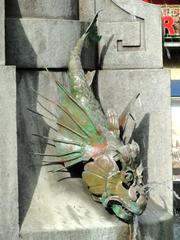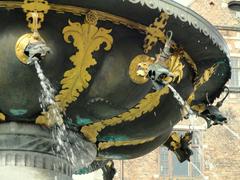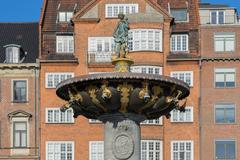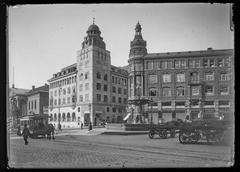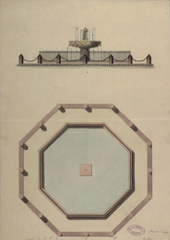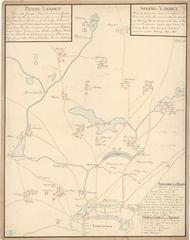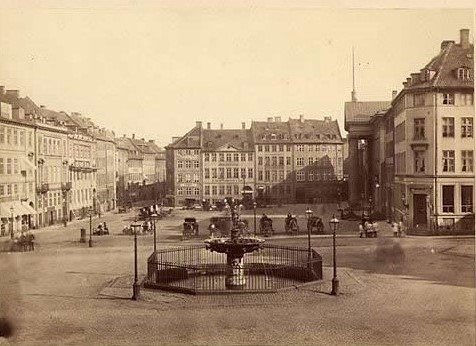
Comprehensive Guide to Visiting Caritasbrønden, Copenhagen, Denmark
Date: 31/07/2024
Introduction
Caritasbrønden, also known as the Caritas Well or Caritas Fountain, is a captivating historical landmark located in the heart of Copenhagen, Denmark. This Renaissance fountain, commissioned by King Christian IV in 1608, stands proudly in Gammeltorv, the city’s oldest square, and is an enduring symbol of Copenhagen’s rich cultural and architectural heritage. Designed by German woodcarver Statius Otto and cast in bronze by Peter Hoffmann from Nuremberg, the Caritas Well is renowned for its intricate design and profound symbolism, which reflects the theological virtue of charity (VisitCopenhagen) (Wikipedia).
Visitors to Caritasbrønden are not only treated to a visual feast but also a deep dive into Denmark’s history. The fountain has undergone significant renovations over the centuries, making it a well-preserved Renaissance marvel that continues to enchant both locals and tourists alike. From its construction origins and intricate design to the modernization efforts and the enchanting ‘Golden Apples’ tradition, Caritasbrønden offers a unique glimpse into the past while remaining a vibrant part of Copenhagen’s present (SpottingHistory).
This comprehensive guide will delve into the fascinating history, practical visitor information, and cultural significance of Caritasbrønden, ensuring that your visit to this iconic fountain is both enriching and memorable. Whether you are a history enthusiast, an art lover, or simply a curious traveler, Caritasbrønden is a must-see attraction that encapsulates the essence of Copenhagen’s charm and historical grandeur.
Table of Contents
- Introduction
- Origins and Construction
- Symbolism and Design
- Modernization and Relocation
- The Golden Apples Tradition
- Practical Visitor Information
- Cultural and Historical Significance
- Preservation and Renovation
- FAQ Section
- Conclusion
Origins and Construction
The Caritas Well was constructed in 1608 by King Christian IV, a monarch renowned for his extensive building projects that significantly shaped Denmark’s architectural landscape. Located on Gammeltorv, the well was built to provide fresh water to the citizens. The well beneath the fountain is six meters deep and remains Denmark’s only preserved Renaissance well (VisitCopenhagen). The fountain’s figures were designed by German woodcarver Statius Otto and cast in bronze by Peter Hoffmann from Nuremberg, using bronze sourced from Danish church bells seized by Christian IV in 1601-02 to cast cannons (VisitCopenhagen).
Symbolism and Design
The Caritas Well is rich in symbolism, reflecting the theological virtue of charity (caritas in Latin). The fountain features a pregnant mother with her children, symbolizing love and charity. The figures stand on a column in a copper basin, elevated above a lower basin on a stone pillar. The female figure sprays water from her breasts, while the little boy ‘pees’ into the basin, a design element that was sealed from 1857 to 1940 due to the sensibilities of the time (Wikipedia). The fountain’s intricate Renaissance design, with its copper basin and bronze figures, makes it a historical and aesthetic treasure (SpottingHistory).
Modernization and Relocation
The Caritas Well resulted from the relocation and modernization of an older fountain erected by Frederik II, who constructed a six-kilometer-long water tube from Lake Emdrup to Gammeltorv, providing adequate water pressure for the fountain. Although ornamental, the well was also part of the city’s water supply system (Wikipedia). Significant renovations were made in 1781, including a new marble plinth engraved with Christian VII’s monogram and the Copenhagen city arms (VisitCopenhagen).
The Golden Apples Tradition
One of the most enchanting traditions associated with the Caritas Well is the ‘Golden Apples’ event. On the monarch’s birthday, currently celebrated on April 16 for Queen Margrethe II, copper balls covered in 24-carat gold, symbolizing golden apples, are placed in the fountain. These golden apples balance on the water streams, creating a mesmerizing spectacle. This tradition dates back to the 18th century and continues to be a significant cultural event in Copenhagen (Wikipedia). The fountain was first used in its new appearance on May 26, 1892, to mark the golden wedding anniversary of King Christian IX and Queen Louise, and it continues to mark royal anniversaries and Constitution Day on June 5 (VisitCopenhagen).
Practical Visitor Information
- Visiting Hours: The Caritas Well is located in a public square and is accessible 24/7. However, the best times to visit are during daylight hours to fully appreciate its details.
- Tickets: There is no entry fee to visit the Caritas Well.
- Guided Tours: Guided tours are available and can provide a deeper insight into the fountain’s history and significance.
- Accessibility: The area around Caritas Well is wheelchair accessible.
- Nearby Attractions: While visiting the Caritas Well, you can also explore other nearby attractions such as the Copenhagen City Hall, Strøget shopping street, and the Round Tower.
Cultural and Historical Significance
The Caritas Well is not just a historical monument but also a cultural symbol of Copenhagen. It represents the city’s rich history and the architectural prowess of the Renaissance period. The fountain’s intricate design and the traditions associated with it make it a must-visit landmark for tourists and locals alike. The well’s historical significance is further highlighted by its role in the city’s water supply system during the Renaissance, showcasing the engineering and architectural advancements of the time (SpottingHistory).
Preservation and Renovation
Over the centuries, the Caritas Well has undergone several renovations to preserve its historical and cultural value. The most notable renovation occurred in 1781, with the addition of the marble plinth. The fountain has been meticulously maintained to ensure that it remains a significant landmark in Copenhagen. Preservation efforts highlight the importance of maintaining historical monuments for future generations. The Caritas Well serves as a reminder of Copenhagen’s rich history and the architectural brilliance of the Renaissance period (VisitCopenhagen).
FAQ Section
Q: What are the visiting hours for Caritas Well?
A: The Caritas Well is accessible 24/7 as it is located in a public square. Daytime visits are recommended to fully appreciate its intricate details.
Q: Is there an entry fee for Caritas Well?
A: No, there is no entry fee to visit the Caritas Well.
Q: Are guided tours available?
A: Yes, guided tours are available and offer a deeper insight into the fountain’s history and significance.
Q: Is the Caritas Well wheelchair accessible?
A: Yes, the area around Caritas Well is wheelchair accessible.
Q: What other attractions are nearby?
A: Nearby attractions include Copenhagen City Hall, Strøget shopping street, and the Round Tower.
Conclusion
Caritasbrønden stands as a testament to Copenhagen’s rich historical and cultural tapestry. This Renaissance fountain, with its intricate design and profound symbolism, offers a unique window into the past while continuing to be a vibrant part of the city’s present. From its origins in 1608 under the aegis of King Christian IV to its modern-day significance, Caritasbrønden captures the essence of charity and architectural brilliance (VisitCopenhagen).
Visitors to Caritasbrønden can appreciate not only its aesthetic beauty but also its role in Copenhagen’s history and cultural traditions. The ‘Golden Apples’ event, the fountain’s architectural significance, and its ongoing preservation efforts highlight the importance of maintaining and celebrating historical monuments. As you explore this iconic fountain, you are invited to delve into the stories and traditions that have shaped Copenhagen, making Caritasbrønden a must-visit landmark for anyone seeking to understand the city’s rich heritage (Wikipedia).
For a truly enriching experience, consider visiting Caritasbrønden during special events or guided tours to fully appreciate its historical and cultural significance. Whether you are captivated by its Renaissance art, intrigued by its historical narratives, or simply enjoying the vibrant atmosphere of Gammeltorv, Caritasbrønden promises a memorable and enlightening visit.
References
- VisitCopenhagen. (2024). Caritas Fountain Golden Apples. VisitCopenhagen
- Wikipedia. (2024). Caritas Well. Wikipedia
- SpottingHistory. (2024). Caritas Well. SpottingHistory
- Danish Design Review. (2023). The Caritas Well. Danish Design Review

